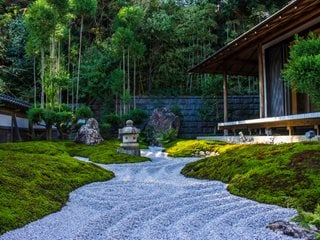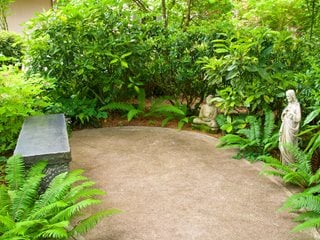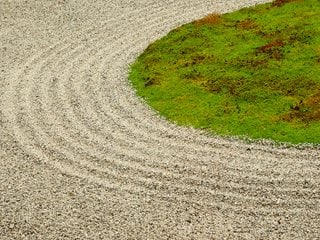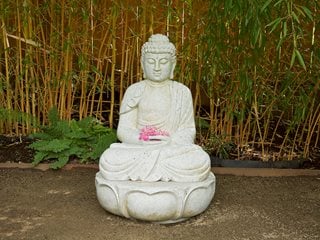Zen Garden Ideas: Add Some Zen to Your Landscape
How to design a space for quiet contemplation with your own backyard Zen gardenFor many people, their yard is a refuge from the outside world, where they can unwind after a hard day’s work. This concept can be expanded upon to create a dedicated space for quiet contemplation. Zen gardens were originally developed by Japanese Buddhist monks as places for meditation. Aspects of Zen design can be incorporated into any home landscape.
WHAT IS A ZEN GARDEN?
A traditional Zen garden, known as karesansui, is a minimalist dry landscape comprised of natural elements of rock, gravel, sand and wood, with very few plants and no water. Man-made components include bridges, statuary and stone lanterns, with an enclosing wall or fence to separate the space from the outside world. Since the focus is on hardscaping, there is little seasonal change and the garden has year-round appeal.
Zen gardens are just one expression of traditional Japanese landscaping. For more design ideas and to explore other types—like tea gardens, stroll gardens, and courtyard retreats—discover the full spectrum of Japanese garden styles.
The basic tenets of Zen gardening can be tailored to suit your own tastes and style. Here’s how to get started on designing your own garden space using Zen principles.
HOW TO MAKE A ZEN GARDEN
Pick a site.
What part of the yard would be suited to a meditation space? How big will it be? Choose a flat, out-of-the-way corner or narrow side yard that is suitable to build a comfortable area to meditate. Make preliminary measurements to help visualize the finished room.
Do your homework.
To get ideas for how you want your space to look, peruse various resources such as the internet, books, and visit local gardens with Zen spaces. Make an idea board or wish list of attributes you want to include.
Use guiding principles.
Zen gardens are structured around seven guiding principles: Austerity (Koko), Simplicity (Kanso), Naturalness (Shinzen), Asymmetry (Fukinsei), Mystery or Subtlety (Yugen), Magical or Unconventional (Datsuzoku) and Stillness (Seijaku). Your Zen garden should promote most or all of these concepts.
Draw a design.
Create a rough sketch to visualize your finished space. For a more elaborate project, you may want to consult a professional landscape designer. If you are using larger rocks, it’s important to know ahead of time where to site them since they are a challenge to lift and set into place.
Be flexible.
Though authentic Zen gardens have few plants and no water features, there are many variations in Zen design where water and plants can play a more prominent role. Don’t be afraid to experiment with different looks.
Make it inviting.
Choose aspects of Zen gardening that please you the most and tailor the garden to suit your tastes. Create a space that you will look forward to spending time in.
Consider scale.
Use materials that are in scale with the size of the garden room as well as the rest of your yard. Bigger stones can easily overwhelm a small space, while small rocks can get lost in a more sweeping landscape.Keep it simple.
A Zen space should be simple and uncluttered, which will elicit a feeling of calm. Use a muted color scheme to relax the mind and create a soothing environment.RELATED: How to Create a Peaceful Garden
ZEN GARDEN ELEMENTS
Individual elements hold deep symbolic meaning. Sand or gravel raked into patterns represents water, while larger rocks suggest islands, mountains, animals, or natural elements such as fire and earth. The emphasis on abstract concepts is intended to spur the imagination and allow the mind to wander, a crucial part of the meditative process. A Zen garden should afford quiet, privacy, and aesthetic beauty.
Include at least some of these primary features which characterize a traditional Zen garden.
Rocks.
These are one of the most important components of Japanese design, as they represent the human desire for eternity and enduring elements in nature. Choosing and siting larger rocks is crucial to a cohesive Zen design. Larger rocks, which act as sculptural elements, should be installed first since they are the heaviest material and are the primary focus.
Gravel.
Gravel is an integral part of Zen gardens, with raked patterns having symbolic meaning. During the early and late part of the day, the low angle of the sun highlights the texture and patterns of the gravel, creating an ever-changing scene that’s visually engaging. The act of raking gravel is part of the meditative process and an acquired skill that helps improve mental concentration.
Though sand can be used, gravel is more durable and easier to maintain. Use finely crushed gravel, pea gravel or small smooth pebbles which will be easy to rake into patterns. Light neutral colors of white, cream or grey are most typically used.
Patterns drawn in the gravel are used to signify a season or evoke a certain mood. Lines around larger rocks simulate water ripples, while wavy lines are reminiscent of a meandering stream. A straight line design can invoke serenity, leading the eye through the landscape or simulating a frozen winter scene.
Use a fine-toothed metal rake to smooth the gravel, then a specially designed, wide-toothed rake to draw the pattern.
Screening.
To create a secluded garden room, enclose the area with a wall, fencing, bamboo screening, lattice panels or formal hedging.
Statuary.
A statue can serve as inspiration for meditation and become a major focal point. These typically include Buddha figurines or Japanese lanterns. Place in a prominent place in the garden.
Pathway.
A pathway can lead visitors into the garden or be placed through the gravel area to make it more accessible to maintain. Choose materials that will contrast with the larger rocks and gravel, such as darker colored stepping stones. Consider the placement of the pathway in relation to how it will affect your experience of the garden. Does it lead the eye through the space, or does it draw attention to particular features? A straight pathway looks more formal, while a meandering path creates stopping points along the way to linger and observe.
Seating.
Zen gardens are meant to be viewed from a particular vantage point. Place a stone bench or comfortable chair in a spot where you can most enjoy the garden.
Water.
Though water is not part of a traditional Zen garden, the sound of moving water can create a more soothing environment that is conducive to meditation. A trickling Asian-style fountain or waterfall will help drown out urban noise.
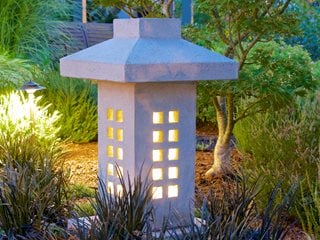
Stone pagoda lantern. Gardener: David Best. Designers: Barbara Hilty and Adriana Berry. Photo: Janet Loughrey.
Lighting.
An often overlooked aspect of home landscaping, lighting adds aesthetic appeal and allows for time spent outdoors during the evenings. Illuminate pathways, statuary, or uplight trees.
Plants.
While Zen gardens typically use few plants, you can tailor this aspect to your own tastes and style. The type of plants used in Zen gardens tend to be low and creeping to complement rather than overwhelm the hardscaping. Flowers are sparse or non-existent, while foliage should be in neutral shades of green to evoke serenity and harmony. The best plants for a Zen garden include bonsai, topiaries, dwarf conifers, Japanese maples, azaleas, bamboo, sedges, creeping ground covers, ferns and mosses. The amount of light your space receives will determine whether sun or shade lovers will work best.
HOW TO MAINTAIN A ZEN GARDEN
Despite its austere appearance, a Zen garden requires regular maintenance to look its best. Caring for the garden is considered an important part of the meditative process.
Rake gravel.
Regular raking will help to keep patterns crisp and the gravel looking fresh.
Pick up leaves.
To keep the garden looking neat, regularly pick out or rake fallen leaves from the gravel and clean up any loose debris around stones and statuary.
Weed.
Keep gravel and planting areas free of weeds. This will be a more regular task during summer when weeds are more prolific, with little or no weeding necessary during colder months.
Prune.
Keep plants pruned to maintain a neat look. Shrubs can be kept sheared or shaped into topiaries. Cut out dead branches or growth as needed, and remove spent flowers. Trim creeping groundcovers away from gravel areas.

Join us for our next webinar!
Coming September 2025
Get more info & sign up to be notified when registration opens!
RELATED:
Find Your Garden Style
Rock Garden Design
Hillside Landscaping Ideas
Moon Garden Design
Seattle Zen Front Yard
